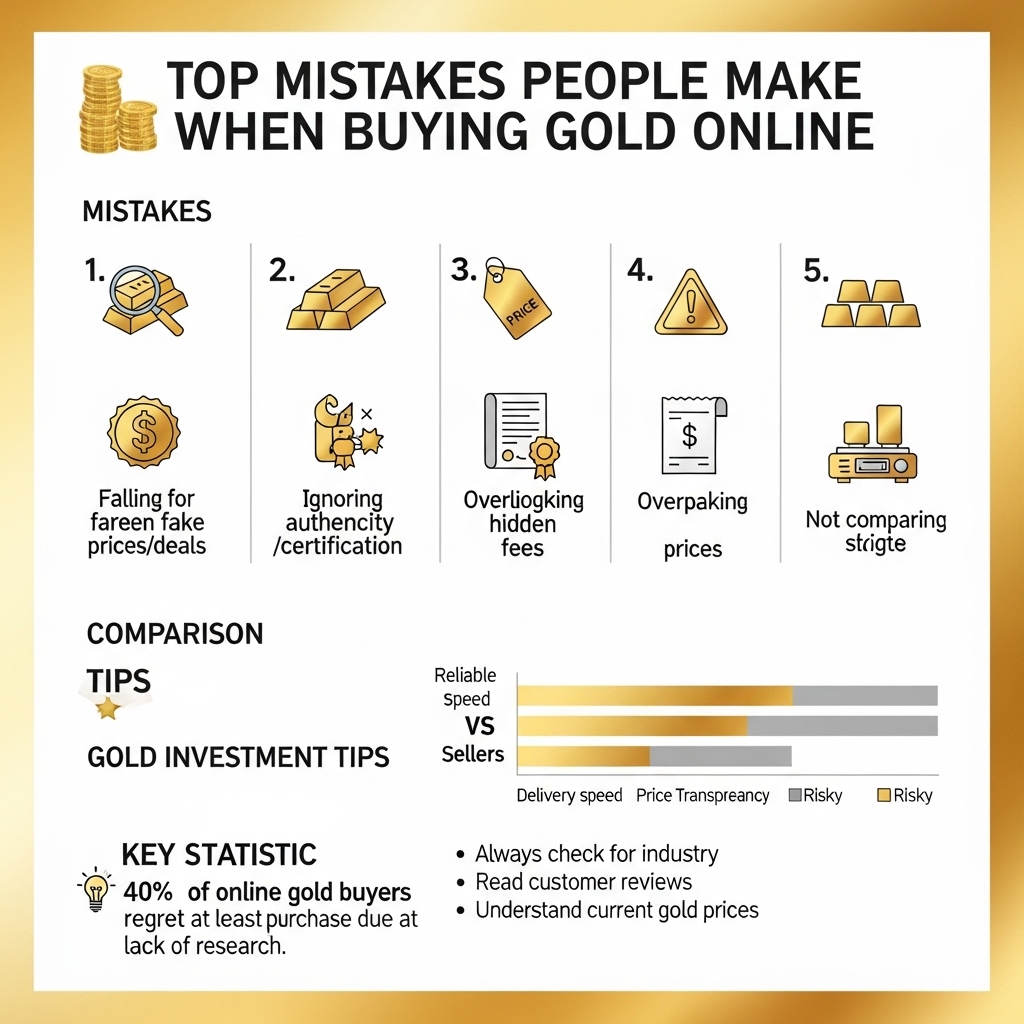Top Mistakes People Make When Buying Gold Online: What Investors Need to Know
In today’s ever-changing financial landscape, gold continues to shine as a pillar of stability and a safeguard against economic volatility. In fact, with global inflation concerns and recent market fluctuations, more investors than ever are turning to gold as a trusted store of value. Online gold buying has surged in popularity, offering convenience and competitive pricing—but it also comes with its own set of hidden pitfalls.
Before you hit buy on that gleaming gold bar or coin, it’s essential to understand the common mistakes that can undermine your investment. In this post, we’ll break down the top missteps investors make when purchasing gold online—from falling for high premiums and shady sellers to overlooking critical details like storage and authenticity. You’ll also discover practical tips to ensure your investments remain secure and profitable.
Understanding these common hurdles is crucial, especially in a digital gold-buying world where scams are evolving. Whether you’re a seasoned precious metals investor or new to gold, avoiding these mistakes can help you take full advantage of gold’s financial benefits, preserve your capital, and feel confident amid market trends. Let’s uncover how you can protect your wealth and make smarter, safer gold purchases online.
Gold Market Analysis and Key Insights
When investing in gold online, understanding the intricacies of the market is paramount. Many buyers fall into common pitfalls due to rapidly shifting trends, misinformation, and lack of due diligence. This section outlines crucial market insights, current trends, investment considerations, and expert guidance to help buyers make informed decisions.
Gold Market Trends and Data
The gold market has seen substantial volatility over the past decade but remains an attractive option for portfolio diversification and hedging against inflation. According to the World Gold Council, global demand for gold rose by nearly 18% in 2023, reaching approximately 4,740 metric tons. Geopolitical uncertainties, inflationary pressures, and fluctuating interest rates have driven investment demand, with central banks and private investors increasing their gold holdings. Online gold purchases have also risen, bolstered by accessible digital platforms and lower transaction costs. However, fake listings, unreliable vendors, and opaque pricing practices remain risks for inexperienced buyers.
Investment Benefits and Critical Considerations
Gold offers inherent benefits, including liquidity, tangible asset backing, and a historic track record of retaining value during market downturns. Its negative correlation with equities makes it a sought-after safe-haven asset. However, online buyers must consider transaction costs, storage options, and authenticity verification. Price premiums can vary widely from one platform to another; careful comparison is crucial. Overlooking these factors can decrease potential returns, erode capital, or even result in losses due to scams.
Expert Recommendations
Industry experts stress the importance of sourcing gold from reputable online dealers certified by organizations such as the London Bullion Market Association (LBMA) or national mints. They recommend verifying product authenticity through third-party certification and investing in physical gold (coins or bars) rather than unallocated gold contracts, which may not guarantee physical delivery. Prospective buyers should always research vendor reviews, compare pricing, and ensure secure payment and delivery methods before transacting. By staying informed and cautious, investors can avoid the top mistakes and reap the rewards of gold investment.

Gold Investment Strategies and Options
When buying gold online, it’s essential to understand the spectrum of investment options and employ effective strategies to minimize mistakes. Gold can be acquired in forms such as physical bullion (coins, bars), exchange-traded funds (ETFs), mining stocks, or even digital gold platforms. Each option serves different investor profiles—while physical gold provides the reassurance of tangible assets, ETFs and mining stocks offer liquidity and exposure without the need for secure storage.
Assessing your risk tolerance and appropriately allocating gold in your portfolio is crucial. Common advice suggests allocating 5-10% of a diversified portfolio to gold as a hedge against inflation and economic downturns. Overexposure increases risk, as gold can be volatile and lacks yield compared to other asset classes. Balancing gold holdings with equities, bonds, and other diversifiers reduces overall portfolio risk.
Comparing investment methods is vital: physical gold entails premiums, storage, and insurance costs, while digital and ETF investments charge management fees but are easier to buy, sell, and trade. Mining stocks may offer growth potential but come with corporate risks unrelated to gold’s price. Investors often err in selecting methods incompatible with their goals or risk profiles.
Market timing is another common pitfall. Attempting to time gold purchases based on short-term price movements can lead to buying at peaks and selling at lows. A strategic approach—such as dollar-cost averaging, where you invest fixed amounts at regular intervals—smooths out price volatility and reduces emotional trading decisions.
In summary, a thoughtful gold investment plan involves choosing appropriate forms, managing risks through allocation, carefully comparing options, and maintaining a disciplined purchasing strategy, all of which help investors avoid costly mistakes when buying gold online.
Market Performance and Outlook
Gold has long held its status as a safe-haven asset, delivering strong performance during periods of economic uncertainty. Historically, its price surged during crises such as the 2008 financial collapse and again in 2020, briefly surpassing $2,000 per ounce amid the COVID-19 pandemic. Over the past decade, gold’s average annual return hovered between 6-8%, underscoring its resilience against inflation and market volatility.
Currently, the gold market remains robust, supported by persistent geopolitical tensions, central bank buying, and concerns over inflation. In 2023 and early 2024, gold prices fluctuated between $1,800 and $2,100 per ounce, reflecting investor sentiment amid rising interest rates and global economic uncertainty. Increased demand from both institutional and retail investors has contributed to sustained price strength.
Looking ahead, the gold market is expected to remain favorable. Analysts predict moderate price appreciation, especially if inflation persists or global economic challenges intensify. Factors such as central bank policies, currency fluctuations (particularly the US dollar), and international conflict will continue to shape gold’s trajectory. For online gold buyers, this means potential for both portfolio diversification and growth, but also heightened price sensitivity.
Economic indicators—such as inflation trends, interest rates, and economic growth—directly impact gold prices. In periods of high inflation or low real interest rates, gold typically attracts both seasoned and new investors. As these factors evolve, buyers should remain vigilant, avoid impulsive decisions, and ensure due diligence when purchasing gold online to maximize value and minimize risk.
Frequently Asked Questions About Gold Investment
What is the most common mistake when buying gold online?
One of the top mistakes buyers make is failing to research the dealer’s reputation. Purchasing from unverified or unreviewed sources can lead to scams or counterfeit gold. Always check for dealer credentials, customer reviews, and ratings from organizations like the Better Business Bureau.
How can I avoid overpaying for gold?
Many buyers overlook comparing spot prices, premiums, and extra fees (such as shipping or insurance). Compare prices across several reputable dealers and always account for additional costs before making a purchase.
Is it safe to buy gold online?
It can be safe if you use well-known, accredited dealers and secure payment methods. Avoid deals that seem too good to be true, verify website security, and confirm the dealer’s return and refund policies before making a purchase.
What gold products should beginners avoid?
First-time investors sometimes buy collectible coins or numismatics, which often carry higher premiums. Beginners generally do better with well-known bullion coins or bars, which are easier to buy and sell at market prices.
Should I buy physical gold or paper gold?
Physical gold gives you direct ownership but requires secure storage and insurance. Paper gold (like ETFs) tracks gold’s price but doesn’t provide physical possession. Decide based on your investment goals and comfort with security arrangements.

Final Thoughts on Gold Investment
In summary, avoiding the common pitfalls—such as neglecting thorough research, falling for scams, overlooking fees, and ignoring authenticity—can make all the difference when purchasing gold online. As an investor, remember that due diligence is essential: always verify the credibility of dealers, compare pricing, and insist on transparent documentation. Gold remains a time-tested way to diversify your portfolio and protect your wealth, but success hinges on informed decisions and vigilance against mistakes. For the best results, align your gold investments with your broader financial goals and only buy from reputable sources. Ready to invest wisely in gold? Take the next step by subscribing to our newsletter for more tips or sharing your experiences in the comments below!